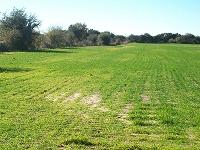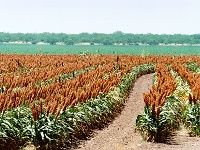

| February 3, 2007 |
 |
|---|
What is the number one question being asked? Does this wheat have a chance of making grain? It was an impressive site to see all the wheat that emerged after the snow melted off. The wheat that is just now emerging will have several challenges before it will have grain to harvest.
 Wheat producers should consider making a fertilizer application as soon as soil temperatures increase. Between February 15 and March 15 the wheat will reach a stage of growth where nutrients and water uptake will increase significantly. If producers intend to get the most from the dollars invested on fertilizer they need to apply nutrients soon. Soil nutrient levels will need to be at a high level when the formation of the head occurs (shortly before rapid spring growth begins). If the head can be found above the soil surface the producer has lost the opportunity to impact the number of spikelets per head and the number of seeds per spikelet.
Wheat producers should consider making a fertilizer application as soon as soil temperatures increase. Between February 15 and March 15 the wheat will reach a stage of growth where nutrients and water uptake will increase significantly. If producers intend to get the most from the dollars invested on fertilizer they need to apply nutrients soon. Soil nutrient levels will need to be at a high level when the formation of the head occurs (shortly before rapid spring growth begins). If the head can be found above the soil surface the producer has lost the opportunity to impact the number of spikelets per head and the number of seeds per spikelet.
In some wheat fields, Wild oats are just now reaching the three-leaf growth stage. At this stage, the Wild oat plants can still be controlled with several herbicides that are available. The three weed control products that don't have a grazing restriction are Puma, Finesse Grass and Broadleaf and Osprey. We should have at least two weeks remaining for the application of these herbicides to control Wild Oats. It will be important that the following conditions exist to get the best possible control using Puma: 1) check the weather forecast and make sure that night time temperatures will be above 40 degrees for two days prior and following the application, and 2) have adequate soil moisture at the time of application. Preferably, producers will apply the herbicide using 20 gallons of water per acre. If the opportunity occurs in February, I will be trying to establish a Wild Oat control test. We will just have to wait and see.
For your information there will be a cotton production conference held at San Angelo on March 21, 2007. There are a number of specialists from across the state involved in this activity. The information provided at this meeting will be useful to the agents in cotton producing counties.
As you know the way we design and conduct cotton variety tests has changed. I still attempt to include the varieties that the producer wants and varieties that perform well in their county. However, there are many new varieties being introduced to the market in 2007. Our main thrust is to eliminate varieties that do not perform before they make it into large scale production. To do this we have to put varieties into a wide range of tests. We are serving our producers well if we can identify what genetically superior lines are available and what their growth and development traits are. Contact me soon and let's design your 2007 Result Demonstrations.
Linked is the production data from cotton variety tests conducted in 2006. With the hot dry year we had in 2006 the fiber length and strength in most tests was very impressive. You can tell by the notes that several final reports are still being developed. As soon as the information is available please send it to me. THANKS!
There are a lot of winter weeds growing on land that is to be planted to cotton this spring. The winter weeds are using valuable soil moisture that should be reserved for the cotton crop to be planted. Since we have more than 60 days before planting, several different herbicides can be considered. You need to determine what kind of weeds you have and make sure that they are listed on the herbicide label. The least expensive broadleaf control herbicide is 2,4-D and it will eliminate a wide range of weeds. If the maximum daytime air temperatures are cool then the Ester formulation should be used. If you are concerned about other weeds that may emerge prior to planting you may want to include a herbicide that is soil active for a short period of time. Special consideration should be given to the crop that is going to be planted; use only approved herbicides and rates. Tests were conducted in 2002 and 2003 on controlling winter weeds; the links to the studies are (http://sanangelo.tamu.edu/agronomy/newsltr/weed02a.htm) and (http://sanangelo.tamu.edu/agronomy/newsltr/weed05.htm). The herbicides listed in the last table in each report is linked to a picture of that treatment in the test.
 It is time to request Corn, Grain Sorghum and Forage Sorghum seed for 2007 result demonstrations. If you need additional information about the varieties and hybrids available, I have compiled a list of company web sites and the URL is: http://sanangelo.tamu.edu/agronomy/newsltr/company.htm. Companies need to be contacted in the near future to acquire the seed you need for testing.
It is time to request Corn, Grain Sorghum and Forage Sorghum seed for 2007 result demonstrations. If you need additional information about the varieties and hybrids available, I have compiled a list of company web sites and the URL is: http://sanangelo.tamu.edu/agronomy/newsltr/company.htm. Companies need to be contacted in the near future to acquire the seed you need for testing.
On Monday February 12, there will be a training conducted at Abilene for producers needing to obtain a Private Applicators License. For more details and to register for the meeting call Gary Bomar at (325) 672-6048.
There will be a meeting conducted February 8, starting in the afternoon at the Texas A&M Agricultural Research and Extension Center north of San Angelo, Texas. The educational meeting will be worth 5 CEUs for TDA license holders that complete the course requirements. For additional information contact the Tom Green County Extension office at (325) 659-6522.
There will be a meeting conducted during the Texas Farm and Ranch Wildlife Expo (Abilene, Texas) on February 20 & 21, 2007. There are several educational meeting being conduced where Texas Department of Agriculture CEUs are available. For additional information contact Gary Bomar at (325) 672-6048.
Don't forget that your TDA pesticide applicators license will expire the end of February. If you have not gotten your paperwork for renewal you may want to contact the TDA.
 February 1, Travis County, Texas and Oklahoma Physiology Study Group Meeting
February 1, Travis County, Texas and Oklahoma Physiology Study Group Meeting
 February 1, Taylor County, Soil and Soil Fertility
February 1, Taylor County, Soil and Soil Fertility
 February 5, District Office, Office Conference
February 5, District Office, Office Conference
 February 6, Howard County, Plant Growth and Development
February 6, Howard County, Plant Growth and Development
 February 8, Callahan County, Multi-County Forage Production Meeting
February 8, Callahan County, Multi-County Forage Production Meeting
 February 8, Tom Green County, Multi-County Pesticide Training–Drift Minimization
February 8, Tom Green County, Multi-County Pesticide Training–Drift Minimization
 February 15, El Paso County, Cotton and Pecan Workshop
February 15, El Paso County, Cotton and Pecan Workshop
 February 20 & 21, Taylor County, Texas Farm and Ranch Wildlife Expo
February 20 & 21, Taylor County, Texas Farm and Ranch Wildlife Expo
 February 22, Burnet County, Plant Growth and Development
February 22, Burnet County, Plant Growth and Development
 March 5, District Office, Office Conference
March 5, District Office, Office Conference
 March 14, Llano County, Plant Growth and Development
March 14, Llano County, Plant Growth and Development
 March 21, Tom Green County, Concho Valley Cotton Conference
March 21, Tom Green County, Concho Valley Cotton Conference
 March 21, Tom Green County, Southern Rolling Plains Cotton Growers Meeting
March 21, Tom Green County, Southern Rolling Plains Cotton Growers Meeting
 March 22, Brown County, Ag Day
March 22, Brown County, Ag Day
 March 29, Tom Green County, BioEnergy Training
March 29, Tom Green County, BioEnergy Training
Sincerely,
|